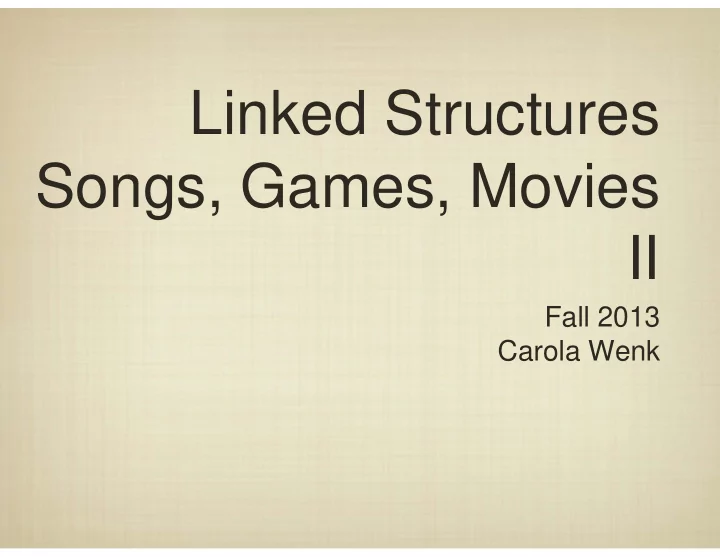

Linked Structures Songs, Games, Movies II Fall 2013 Carola Wenk
Linked Lists x: y: “hello” “world!” The simplest dynamic structures is a linear ordering of data, called a “linked list”. We saw that is was easy to modify a linked structure without “touching” all of the data. How do we implement additions and deletions? Is finding an item efficient?
Adding Items Actually, what does it mean to add to a linked list? How do we add to the beginning of the list? . . . L:
Adding Items Actually, what does it mean to add to a linked list? How do we add to the beginning of the list? . . . L: x:
Adding Items Actually, what does it mean to add to a linked list? How do we add to the beginning of the list? . . . L: x:
Adding Items Actually, what does it mean to add to a linked list? How do we add to the beginning of the list? . . . L,x: Adding to the front of a list is easy and requires constant work.
Adding Items Actually, what does it mean to add to a linked list? How do we add to the end of the list? p: . . . L: x:
Adding Items Actually, what does it mean to add to a linked list? How do we add to the end of the list? p: . . . L: x:
Adding Items Actually, what does it mean to add to a linked list? How do we add to the end of the list? p: . . . L: x:
Adding Items Actually, what does it mean to add to a linked list? How do we add to the end of the list? p: . . . L: x:
Adding Items • Actually, what does it mean to add to a linked list? How do we add to the end of the list? p: . . . L: x: Sadly, we must traverse the entire structure just to add to the end!
Adding Items • Actually, what does it mean to add to a linked list? How do we add to the end of the list? L_head: L_tail: . . . x: If we kept track of the end of the list, then we could add an item with just a few operations.
Adding Items • Actually, what does it mean to add to a linked list? How do we add to the end of the list? L_head: L_tail: . . . x: But, if we wanted to insert anywhere else, we’re still out of luck.
Finding Items • To find anything in a linked list, we again need to (potentially) traverse the entire structure. The implementation is easy, but in the worst case it is no better than a linear search, regardless of whether the linked list is ordered or not! . . . L: Finding an element is no better than in an array; it takes time that is linear in the size of the list.
Removing Items • We must also keep track of the preceding element, so that we can reassign its neighbor. p: . . . L: x The implementation is easy, but in the worst case it is no better than a linear search, regardless of whether the linked list is ordered or not!
Removing Items • We must also keep track of the preceding element, so that we can reassign its neighbor. p: . . . L: x The implementation is easy, but in the worst case it is no better than a linear search, regardless of whether the linked list is ordered or not!
Removing Items • We must also keep track of the preceding element, so that we can reassign its neighbor. p: . . . L: x The implementation is easy, but in the worst case it is no better than a linear search, regardless of whether the linked list is ordered or not.
Recommend
More recommend